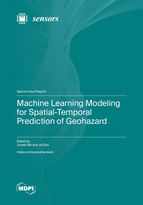Machine Learning Modeling for Spatial-Temporal Prediction of Geohazard
A special issue of Sensors (ISSN 1424-8220). This special issue belongs to the section "Environmental Sensing".
Deadline for manuscript submissions: closed (10 April 2023) | Viewed by 48452
Special Issue Editors
Interests: geohazard prediction; machine learning
Interests: artificial intelligence; geohazards; geospatial analysis; geomorphology; risk mitigation
Special Issues, Collections and Topics in MDPI journals
Special Issue Information
Dear Colleagues,
Geohazards, such as landslides, rock avalanches, debris flow, ground fissures, and ground subsidence, pose significant threats to life and property. Recently, machine learning (ML) has become the predominant approach in geohazard modeling due to its advantages of providing excellent generalization ability and accurately describing complex and nonlinear behavior.
However, the use of advanced algorithms in deep learning is still poorly understood in this field. Further, there are fundamental challenges associated with ML modeling, including input variable selection, uncertainty quantification, and hyperparameter tuning.
This Special Issue will provide a forum for original research work exploring new frontiers and challenges for the applications of ML for spatial-temporal modeling of geohazards. Moreover, innovative methods and original applications (including but not limited to geohazard prediction, recognition, early warning systems, susceptibility mapping, risk management, spatial modeling, and mitigation measurement) would be appropriate.
The topics of interest include but are not limited to:
- Geohazard modeling;
- Spatial–temporal prediction;
- Machine learning;
- Deep and reinforcement learning;
- Metaheuristic optimized machine learning approach;
- Physics-based and data-driven hybrid modeling.
Dr. Junwei Ma
Prof. Dr. Jie Dou
Guest Editors
Manuscript Submission Information
Manuscripts should be submitted online at www.mdpi.com by registering and logging in to this website. Once you are registered, click here to go to the submission form. Manuscripts can be submitted until the deadline. All submissions that pass pre-check are peer-reviewed. Accepted papers will be published continuously in the journal (as soon as accepted) and will be listed together on the special issue website. Research articles, review articles as well as short communications are invited. For planned papers, a title and short abstract (about 100 words) can be sent to the Editorial Office for announcement on this website.
Submitted manuscripts should not have been published previously, nor be under consideration for publication elsewhere (except conference proceedings papers). All manuscripts are thoroughly refereed through a single-blind peer-review process. A guide for authors and other relevant information for submission of manuscripts is available on the Instructions for Authors page. Sensors is an international peer-reviewed open access semimonthly journal published by MDPI.
Please visit the Instructions for Authors page before submitting a manuscript. The Article Processing Charge (APC) for publication in this open access journal is 2600 CHF (Swiss Francs). Submitted papers should be well formatted and use good English. Authors may use MDPI's English editing service prior to publication or during author revisions.
Benefits of Publishing in a Special Issue
- Ease of navigation: Grouping papers by topic helps scholars navigate broad scope journals more efficiently.
- Greater discoverability: Special Issues support the reach and impact of scientific research. Articles in Special Issues are more discoverable and cited more frequently.
- Expansion of research network: Special Issues facilitate connections among authors, fostering scientific collaborations.
- External promotion: Articles in Special Issues are often promoted through the journal's social media, increasing their visibility.
- Reprint: MDPI Books provides the opportunity to republish successful Special Issues in book format, both online and in print.
Further information on MDPI's Special Issue policies can be found here.








